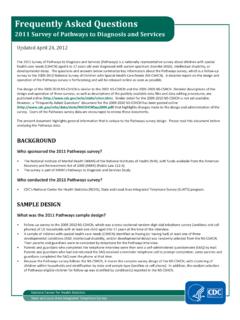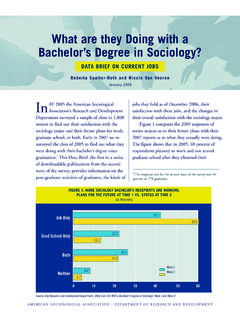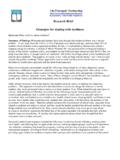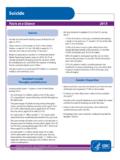Transcription of Top 10 algorithms in data mining - UVM
1 Knowl Inf Syst (2008) 14:1 37 DOI PAPERTop 10 algorithms in data miningXindong Wu Vipin Kumar J. Ross Quinlan Joydeep Ghosh Qiang Yang Hiroshi Motoda Geoffrey J. McLachlan Angus Ng Bing Liu Philip S. Yu Zhi-Hua Zhou Michael Steinbach David J. Hand Dan SteinbergReceived: 9 July 2007 / Revised: 28 September 2007 / Accepted: 8 October 2007 Published online: 4 December 2007 Springer-Verlag London Limited 2007 AbstractThis paper presents the top 10 data mining algorithms identified by the IEEEI nternational Conference on data mining (ICDM) in December 2006: ,k-Means, SVM,Apriori, EM, PageRank, AdaBoost,kNN, Naive Bayes, and CART. These top 10 algorithmsare among the most influential data mining algorithms in the research community. With eachalgorithm, we provide a description of the algorithm, discuss the impact of the algorithm, andreview current and further research on the algorithm.
2 These 10 algorithms cover classification,X. Wu (B)Department of Computer Science, University of Vermont, Burlington, VT, USAe-mail: KumarDepartment of Computer Science and Engineering,University of Minnesota, Minneapolis, MN, USAe-mail: Ross QuinlanRulequest Research Pty Ltd,St Ives, NSW, Australiae-mail: GhoshDepartment of Electrical and Computer Engineering,University of Texas at Austin, Austin, TX 78712, USAe-mail: YangDepartment of Computer Science,Hong Kong University of Science and Technology,Honkong, Chinae-mail: MotodaAFOSR/AOARD and Osaka University,7-23-17 Roppongi, Minato-ku, Tokyo 106-0032, Japane-mail: Wu et , statistical learning, association analysis, and link mining , which are all among themost important topics in data mining research and IntroductionIn an effort to identify some of the most influential algorithms that have been widely usedin the data mining community, the IEEE International Conference on data mining (ICDM, ~icdm/) identified the top 10 algorithms in data mining for presen-tation at ICDM 06 in Hong the first step in the identification process, in September 2006 we invited the ACM KDDI nnovation Award and IEEE ICDM Research Contributions Award winners to each nomi-nate up to 10 best-known algorithms in data mining .
3 All except one in this distinguishedset of award winners responded to our invitation. We asked each nomination to provide thefollowing information: (a) the algorithm name, (b) a brief justification, and (c) a representa-tive publication reference. We also advised that each nominated algorithm should have beenwidely cited and used by other researchers in the field, and the nominations from each nomi-nator as a group should have a reasonable representation of the different areas in data J. McLachlanDepartment of Mathematics,The University of Queensland, Brisbane, Australiae-mail: NgSchool of Medicine, Griffith University,Brisbane, AustraliaB. LiuDepartment of Computer Science,University of Illinois at Chicago, Chicago, IL 60607, USAP. S . YuIBM T. J. Watson Research Center,Hawthorne, NY 10532, USAe-mail: ZhouNational Key Laboratory for Novel Software Technology,Nanjing University, Nanjing 210093, Chinae-mail: SteinbachDepartment of Computer Science and Engineering,University of Minnesota, Minneapolis, MN 55455, USAe-mail: J.
4 HandDepartment of Mathematics,Imperial College, London, UKe-mail: SteinbergSalford Systems,San Diego, CA 92123, USAe-mail: 10 algorithms in data mining3 After the nominations in Step 1, we verified each nomination for its citations on GoogleScholar in late October 2006, and removed those nominations that did not have at least 50citations. All remaining (18) nominations were then organized in 10 topics: association anal-ysis, classification, clustering, statistical learning, bagging and boosting, sequential patterns,integrated mining , rough sets, link mining , and graph mining . For some of these 18 algorithmssuch ask-means, the representative publication was not necessarily the original paper thatintroduced the algorithm, but a recent paper that highlights the importance of the representative publications are available at the ICDM website ( ~icdm/ ).In the third step of the identification process, we had a wider involvement of the researchcommunity.
5 We invited the Program Committee members of KDD-06 (the 2006 ACM SIG-KDD International Conference on Knowledge Discovery and data mining ), ICDM 06 (the2006 IEEE International Conference on data mining ), and SDM 06 (the 2006 SIAM Inter-national Conference on data mining ), as well as the ACM KDD Innovation Award and IEEEICDM Research Contributions Award winners to each vote for up to 10 well-known algo-rithms from the 18-algorithm candidate list. The voting results of this step were presented atthe ICDM 06 panel on Top 10 algorithms in data the ICDM 06 panel of December 21, 2006, we also took an open vote with all 145attendees on the top 10 algorithms from the above 18-algorithm candidate list, and the top 10algorithms from this open vote were the same as the voting results from the above third 3-hour panel was organized as the last session of the ICDM 06 conference, in parallelwith 7 paper presentation sessions of the Web Intelligence (WI 06) and Intelligent AgentTechnology (IAT 06) conferences at the same location, and attracting 145 participants tothis panel clearly showed that the panel was a great and IntroductionSystems that construct classifiers are one of the commonly used tools in data mining .
6 Suchsystems take as input a collection of cases, each belonging to one of a small number ofclasses and described by its values for a fixed set of attributes, and output a classifier that canaccurately predict the class to which a new case notes describe [64], a descendant of CLS [41]andID3[62]. Like CLS andID3, generates classifiers expressed as decision trees, but it can also construct clas-sifiers in more comprehensible ruleset form. We will outline the algorithms employed , highlight some changes in its successor See5 , and conclude with a couple of openresearch Decision treesGiven a set S of cases, first grows an initial tree using the divide-and-conquer algorithmas follows: If all the cases in S belong to the same class or S is small, the tree is a leaf labeled withthe most frequent class in S. Otherwise, choose a test based on a single attribute with two or more outcomes.
7 Makethis test the root of the tree with one branch for each outcome of the test, partition S intocorresponding subsetsS1,S2,..according to the outcome for each case, and apply thesame procedure recursively to each Wu et are usually many tests that could be chosen in this last step. uses two heuristiccriteria to rank possible tests: information gain, which minimizes the total entropy of thesubsets {Si} (but is heavily biased towards tests with numerous outcomes), and the defaultgain ratio that divides information gain by the information provided by the test can be either numeric or nominal and this determines the format of the testoutcomes. For a numeric attributeAthey are {A h,A>h} where the thresholdhis foundby sortingSon the values ofAand choosing the split between successive values that max-imizes the criterion above. An attributeAwith discrete values has by default one outcomefor each value, but an option allows the values to be grouped into two or more subsets withone outcome for each initial tree is then pruned to avoid overfitting.
8 The pruning algorithm is based on apessimistic estimate of the error rate associated with a set ofNcases,Eof which do notbelong to the most frequent class. Instead ofE/N, determines the upper limit of thebinomial probability whenEevents have been observed inNtrials, using a user-specifiedconfidence whose default value is is carried out from the leaves to the root. The estimated error at a leaf withNcases andEerrors isNtimes the pessimistic error rate as above. For a subtree, addsthe estimated errors of the branches and compares this to the estimated error if the subtree isreplaced by a leaf; if the latter is no higher than the former, the subtree is pruned. Similarly, checks the estimated error if the subtree is replaced by one of its branches and whenthis appears beneficial the tree is modified accordingly. The pruning process is completed inone pass through the s tree-construction algorithm differs in several respects from CART [9], for instance: Tests in CART are always binary, but allows two or more outcomes.
9 CART uses the Gini diversity index to rank tests, whereas uses information-basedcriteria. CART prunes trees using a cost-complexity model whose parameters are estimated bycross-validation; uses a single-pass algorithm derived from binomial confidencelimits. This brief discussion has not mentioned what happens when some of a case s values areunknown. CART looks for surrogate tests that approximate the outcomes when the testedattribute has an unknown value, but apportions the case probabilistically among Ruleset classifiersComplex decision trees can be difficult to understand, for instance because information aboutone class is usually distributed throughout the tree. introduced an alternative formalismconsisting of a list of rules of the form if A and B and C and .. then class X , where rules foreach class are grouped together. A case is classified by finding the first rule whose conditionsare satisfied by the case; if no rule is satisfied, the case is assigned to a default rulesets are formed from the initial (unpruned) decision tree.
10 Each path from the rootof the tree to a leaf becomes a prototype rule whose conditions are the outcomes along the pathand whose class is the label of the leaf. This rule is then simplified by determining the effect ofdiscarding each condition in turn. Dropping a condition may increase the numberNof casescovered by the rule, and also the numberEof cases that do not belong to the class nominatedby the rule, and may lower the pessimistic error rate determined as above. A hill-climbingalgorithm is used to drop conditions until the lowest pessimistic error rate is 10 algorithms in data mining5To complete the process, a subset of simplified rules is selected for each class in class subsets are ordered to minimize the error on the training cases and a defaultclass is chosen. The final ruleset usually has far fewer rules than the number of leaves on thepruned decision principal disadvantage of s rulesets is the amount of CPU time and memory thatthey require.









